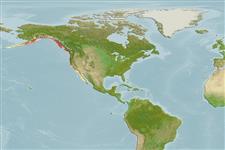Common names from other countries
Environment: milieu / climate zone / depth range / distribution range
Ekologi
; kisaran kedalaman 0 - 40 m (Ref. 290). Temperate
Eastern Pacific.
Length at first maturity / Size / Weight / umur
Maturity: Lm ? range ? - ? cm Max length : 13.0 cm TL jantan/; (Ref. 290)
Girdle: Black leathery covering almost the entire dorsal area. Dorsal ridge area of each valve: small portion; left exposed (Ref. 296).
Surf-zone to 40 m. Usually found on stony or rocky bottoms (Ref. 290); in the middle intertidal zone from Alaska to Point Conception; North of Santa Barbara; also on rocky shore with heavy wave action (Ref. 312). Herbivorous, feeding primarily on red and green algae and benthic diatoms (Ref. 312).
Life cycle and mating behavior
Kematangan | Reproduksi, perkembang biakan | Pemijahan | telur-telur | Fecundity | Larva
Members of the class Polyplacophora are mostly gonochoric. Life cycle: Eggs hatch into lecitotrophic planktonic trocophore larvae (no veliger stage) which later metamorphose and settle on the bottom as young adults.
rujukan utama
Acuan | Koordinator | mitra
Burghardt, G. and L. Burghardt. 2006. (Ref. 296)
Status IUCN Red List (Ref. 130435)
status CITES (Ref. 108899)
Not Evaluated
Not Evaluated
penggunaan manusia
| FishSource |
Alat, peralatan
informasi lanjut
Umur / SaizPertumbuhanpanjang-beratpanjang-panjangMorfologiLarvaKelimpahan
Sumber internet
Estimates based on models
Preferred temperature
(Ref.
115969): 6.1 - 10.9, mean 8.9 (based on 94 cells).
keancaman
Low vulnerability (10 of 100).
kategori harga
Unknown.
